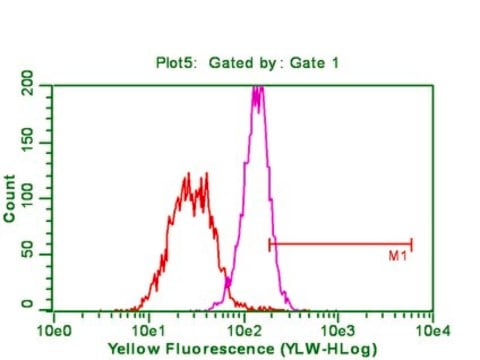MABE647
Anti-acetyl-Histone H3 (Lys27) Antibody, clone RM172
clone RM172, from rabbit
Synonim(y):
Histone H3.3, Histone H3
Wybierz wielkość
Wybierz wielkość
About This Item
Polecane produkty
pochodzenie biologiczne
rabbit
Poziom jakości
forma przeciwciała
purified antibody
rodzaj przeciwciała
primary antibodies
klon
RM172, monoclonal
reaktywność gatunkowa
human
metody
multiplexing: suitable
western blot: suitable
izotyp
IgG
numer dostępu UniProt
Warunki transportu
wet ice
docelowa modyfikacja potranslacyjna
acetylation (Lys27)
informacje o genach
human ... H3F3B(3021)
Opis ogólny
Specyficzność
Immunogen
Zastosowanie
Epigenetics & Nuclear Function
Chromatin Biology
Jakość
Western Blotting Analysis (WB): 1 μg/mL of this antibody detected acetyl-Histone H3 (Lys27) in sodium butyrate treated HeLa acid extract.
Opis wartości docelowych
Postać fizyczna
Przechowywanie i stabilność
Note: Variability in freezer temperatures below -20°C may cause glycerol containing solutions to become frozen during storage.
Inne uwagi
Oświadczenie o zrzeczeniu się odpowiedzialności
Nie możesz znaleźć właściwego produktu?
Wypróbuj nasz Narzędzie selektora produktów.
Kod klasy składowania
12 - Non Combustible Liquids
Klasa zagrożenia wodnego (WGK)
WGK 2
Temperatura zapłonu (°F)
does not flash
Temperatura zapłonu (°C)
does not flash
Certyfikaty analizy (CoA)
Poszukaj Certyfikaty analizy (CoA), wpisując numer partii/serii produktów. Numery serii i partii można znaleźć na etykiecie produktu po słowach „seria” lub „partia”.
Masz już ten produkt?
Dokumenty związane z niedawno zakupionymi produktami zostały zamieszczone w Bibliotece dokumentów.
Active Filters
Nasz zespół naukowców ma doświadczenie we wszystkich obszarach badań, w tym w naukach przyrodniczych, materiałoznawstwie, syntezie chemicznej, chromatografii, analityce i wielu innych dziedzinach.
Skontaktuj się z zespołem ds. pomocy technicznej








